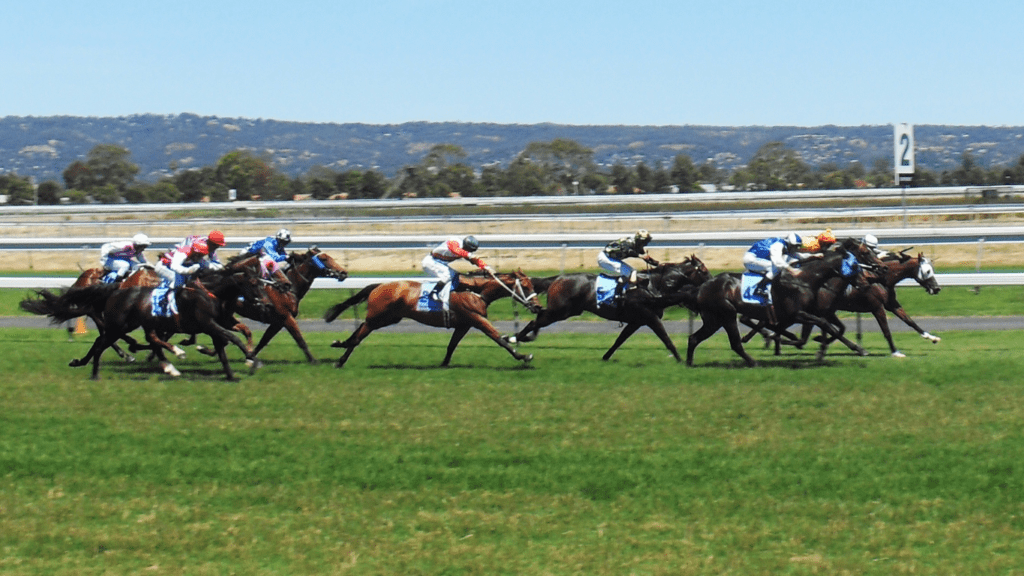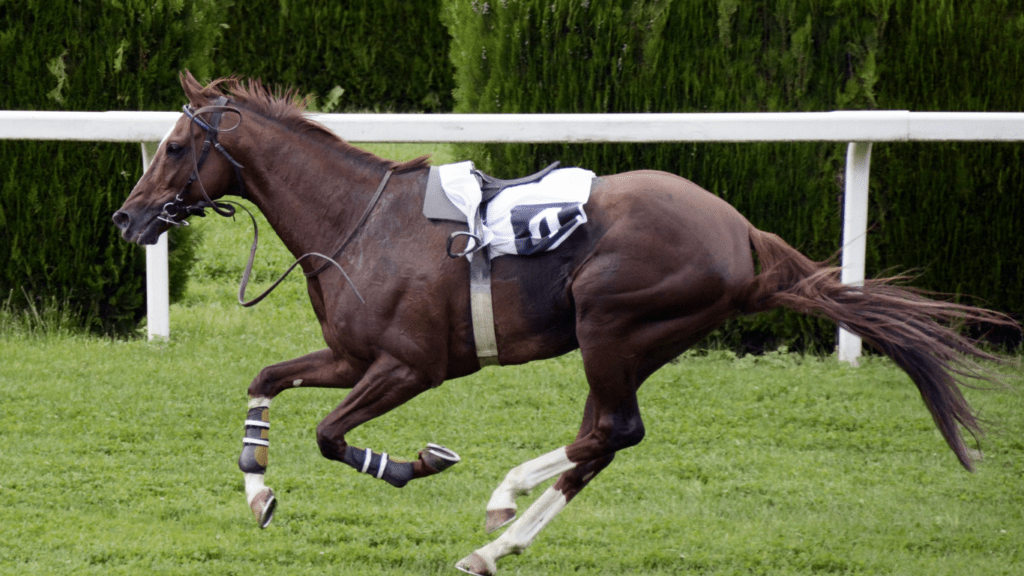Inside Look: What Makes A Champion Racehorse?
Genetics is crucial in determining a racehorse’s potential. Thoroughbred horses, for example, are bred specifically for racing, with pedigrees tracing back hundreds of years. Champion racehorses often have ancestors who were also top performers on the track. In fact, a study published in the journal “Animal Genetics” found that certain genetic markers are associated with superior racing performance.
Training plays an equally significant role. A rigorous and scientifically structured training program can turn a genetically gifted horse into a champion. For instance, horses usually undergo interval training which alternates bouts of high-intensity work with periods of rest to build stamina and speed. Trainers often use specialized equipment like treadmills and swimming pools to enhance the horse’s cardiovascular health without causing joint strain.
Nutrition and healthcare further influence a horse’s performance. Diets rich in high-quality forage and grains provide the necessary energy for intense training and races. Veterinary care, including regular check-ups and preventive treatments, ensures that the horse remains injury-free and in peak condition. Research in “Equine Veterinary Journal” highlights the importance of tailored nutrition plans for optimal health and performance.
Willpower and temperament also matter. A champion racehorse often displays a competitive spirit and a willingness to push through challenging situations. Trainers look for these traits early in a horse’s career and nurture them through positive reinforcement and consistent routines. According to a report in “The Journal of Equine Science,” horses with a calm temperament and high motivation perform better in competitive scenarios.
Thus, a combination of genetics, training, nutrition, healthcare, and willpower contribute to making a racehorse a champion. These interconnected factors, supported by scientific research, reflect the complexity and precision behind nurturing a winning racehorse.
Breeding And Lineage
Breeding and lineage determine a racehorse’s potential, forming the foundation of a champion.
Importance Of Pedigree
Pedigree impacts a horse’s physical and mental traits. Thoroughbreds, commonly bred for racing, often have pedigrees filled with successful ancestors, passing on desirable characteristics. According to research, superior performance correlates with specific genetic markers, which influence speed, endurance, and recovery. Pedigree analysis helps breeders make informed decisions, aiming to pair horses that complement each other’s strengths. Successful breeders use databases and genetic tools to predict offspring potential accurately.
Influential Bloodlines
Certain bloodlines consistently produce champions. For example, the Northern Dancer line, known for speed and stamina, has sired multiple race winners. Similarly, Mr. Prospector’s descendants, noted for their impressive physicality and agility, dominate many major races. Breeders prioritize these influential bloodlines to maximize the chance of producing top-tier racehorses. By analyzing performance records and genetic data, breeders identify the best matings, aiming to replicate the traits that define a winning horse.
Physical Attributes
Champion racehorses possess physical traits that set them apart from others. These attributes play a crucial role in their performance and success on the racetrack.
Ideal Conformation
Ideal conformation in a racehorse ensures optimal performance and fewer injuries. Conformation includes the alignment and proportion of the horse’s body parts. For example, a balanced body with a deep, sloping shoulder allows for a longer stride. Straight legs reduce the risk of joint stress injuries and ensure efficient movement. A short back enhances strength and stability, while a well-angled hindquarters provide powerful propulsion. These physical traits contribute to smoother, more efficient motion during races.
Muscular Strength and Endurance
Muscular strength and endurance are vital for a racehorse’s success. A well-developed musculature supports speed and stamina. Powerful hindquarters drive the horse forward, while strong forelimbs help maintain optimum speed.
Endurance is crucial for maintaining peak performance throughout a race. High-performance racehorses typically have a muscle fiber composition that includes a higher proportion of fast-twitch fibers for bursts of speed and slow-twitch fibers for stamina. Regular, focused training builds and maintains these muscles, enhancing the horse’s overall physical condition.
Champion racehorses benefit immensely from these physical attributes, which combine to deliver exceptional performance on the track.
Training And Conditioning

Champion racehorses undergo rigorous training and conditioning to reach peak performance. These programs start early and evolve over time to maintain and enhance fitness levels.
Early Training Techniques
Young racehorses begin their training after weaning, usually around six months of age. Initial steps focus on ground handling, where they learn to respond to basic commands, wear a halter, and lead calmly. This groundwork builds trust and communication between the horse and trainer.
At approximately one year old, horses start lunging exercises. These exercises involve the horse moving in a circle around the trainer, promoting balance and muscle development. Introducing tack like saddles and bridles follows, allowing the horse to accustom to the equipment used in racing.
Ongoing Fitness Programs
Once basic training is complete, ongoing fitness programs aim to build:
- endurance
- speed
- strength
Interval training is a common practice, involving alternating periods of high and low intensity. This method improves cardiovascular fitness and mimics race conditions.
Hill work is another essential component. Running uphill increases muscular strength and stamina. Treadmills and swimming pools offer low-impact options, reducing the risk of injury while maintaining fitness.
Throughout their career, racehorses follow a diet tailored to high energy needs, incorporating quality forage and grains. Regular veterinary check-ups ensure they remain injury-free and perform at their optimum level.
Mental And Emotional Factors
Champion racehorses excel due to not only their physical attributes but also their mental and emotional strength. These horses exhibit remarkable temperament and resilience under pressure.
Temperament And Disposition
Temperament significantly affects a racehorse’s performance. Champion racehorses are generally calm, focused, and trainable, qualities essential for peak performance.
Calm horses handle pre-race environments well, reducing the risk of wasting energy through nervousness. Examples include thoroughbreds known for their composed nature in paddocks and at starting gates.
A focused horse maintains attention during training and races, leading to consistent improvements and better race outcomes. Trainable horses readily adapt to training regimens, allowing trainers to optimize their abilities efficiently.
Handling Stress And Pressure
- Handling stress and pressure distinguishes champions from average racehorses. These horses cope well with the physical and mental demands of racing.
- Effective stress management ensures that horses perform well under race conditions.
- Horses that remain composed during high-stress phases like entering the starting gate or during a critical part of a race often outperform those that falter.
- Techniques such as exposure to various racing environments and gradual acclimatization help horses develop resilience.
- Regular interaction and positive reinforcement from handlers also build trust, ensuring horses stay calm during pressure situations.
Role Of The Trainer
Trainers are pivotal in shaping a champion racehorse, leveraging their expertise and tailoring plans to optimize each horse’s potential.
Expertise And Experience
A trainer’s expertise directly impacts a racehorse’s performance. Trainers with years of experience know the nuances of equine behavior and physicality, allowing them to formulate effective training regimens. Successful trainers often have backgrounds as jockeys or have worked under veteran trainers, gaining hands-on experience and learning best practices. A seasoned trainer can identify a horse’s strengths and weaknesses, adapting methods to suit individual needs.
Developing A Customized Plan
Tailoring a training program to a specific horse maximizes its potential. Trainers develop personalized plans based on the horse’s age, breed, and physical condition. For example, younger horses might focus more on foundational training like ground handling and lunging exercises. In contrast, older horses could engage in advanced interval training and hill work to boost stamina and strength. Nutritional plans are also customized, with diets adjusted to provide the right balance of energy and nutrients specific to each horse’s requirements.


 Michaello Thomasters, the visionary founder of Bet Roll Gamble, has built a dynamic platform that serves as a hub for betting enthusiasts across various arenas, including sports, poker, horse racing, and esports. With a passion for providing valuable insights and strategies, Thomasters aimed to create a space where both novice and experienced bettors can enhance their skills and stay ahead of trends.
Michaello Thomasters, the visionary founder of Bet Roll Gamble, has built a dynamic platform that serves as a hub for betting enthusiasts across various arenas, including sports, poker, horse racing, and esports. With a passion for providing valuable insights and strategies, Thomasters aimed to create a space where both novice and experienced bettors can enhance their skills and stay ahead of trends.